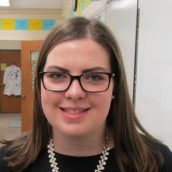Ehlers Danlos Syndrome: A Rare Genetic Disorder
Dislocations and sprains are common symptoms (A Best of SNO Article – recognized by School Newspapers On-Line)
Photo by Fiona McWhinnie (through Creative Commons)
Hyperextension of the elbows beyond 10 degrees – one point for each elbow, a condition sometimes associated with EDS.
A simple leg kick at cheer practice caused my whole world to turn around. As I kicked my leg up, I felt a sharp pain and heard a popping noise. Unable to keep my balance, I fell to the ground. I didn’t know what was causing these symptoms, but I knew that something was wrong in my body.
My mom took me to the clinic, and they referred us to the orthopedic department. The next day, I had my first orthopedic appointment; there would be dozens more. We learned that I had dislocated my knee, which doesn’t typically occur without some sort of trauma such as a hit in a football game or a car accident. I was placed in a stabilizing knee brace, put on crutches, and physical therapy was scheduled for the next three months. When my recovery took twice as long as it should have, our fears that something was really wrong were realized. I was only 13.
After my lengthy recovery period, I was finally cleared to start cheering again with the rest of my friends. However, I was unable to make it through the season as my knee began giving out beneath me. I was placed in wheelchair to reduce my risk of falling. After this incident, my doctor decided that there was no way to fix my knee without surgical intervention. The surgery was successful, and after six months of physical therapy, I regained my ability to walk, until, my other knee started dislocating, which also required surgical intervention.
Five surgeries, countless procedures, and hundreds of appointments later, I was diagnosed with a rare, genetic connective tissue disorder known as Ehlers Danlos Syndrome (EDS). EDS is a group of rare heterogeneous connective tissue disorders caused by a mutation, and leading to a deficient amount of collagen in the body. With a lack of family history regarding this disease, the question arose as to how I had acquired it. It turns out that my condition was a spontaneous mutation. This means that the “perfect” (how ironic) conditions to support a mutation were present in my mother’s womb when I was conceived. (Information gathered from the Ehler Danlos National foundation at www.EDNF.org.)
Collagen is a vital protein most commonly found in connective tissue that is often referred to as the glue that holds your body together. Without it, your body could quite literally fall apart. Decreased amounts of collagen in the body. The decreased amount of collagen in the body causes the connective tissue to be too loose, resulting in a condition known as hypermobility. Connective tissue is very widespread in the body, forming everything from parts of organs to skin to the ligaments and tendons that hold your joints in place. It stands to reason why EDS can be so detrimental to a body.
Since my diagnosis, I have undergone five more surgeries, countless more procedures, and hundreds of more doctor’s appointments. I have also been diagnosed with an additional eight diseases. My gastrointestinal tract, reproductive system, urinary tract, skeletal system, muscular system, and nervous system have all been affected. Not a day goes by where I am not in constant pain, have to take medication, or wear some sort of brace. Joint subluxations, dislocations, and sprains are the most common and frequent symptoms among EDS patients, so much so that, the EDS community coined the phrase, “My joints go out more than I do.” Physicians often take action to stabilize joints through bracing and or surgery. As of now, a cure has not been found for EDS, and patients are forced to treat the symptoms as they arise. According to Dr. Carly Guss, a pediatrician at Children’s Hospital in Boston, “Patients with EDS require a multidisciplinary approach in which each member of the team works together to treat the patient.”
Despite all of these challenges, I have still managed to live a full and happy life, which would be impossible without the constant care and support I receive from my friends, family and physicians. I am graduating from AHS this June, and plan to major in Pre-Med. It is my goal to contribute as much as possible to understanding this disease, and finding a way to cure it.
According the Ehlers Danlos National Foundation, 1 in 50,000 people have this disease. You can find more information about EDS at www.ednf.org.

Emily Johnson is a member of the Class of 2016. She joined the Green Wave Gazette during her senior year. Emily hopes you enjoy reading the Green Wave...

